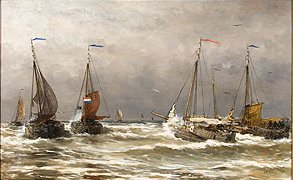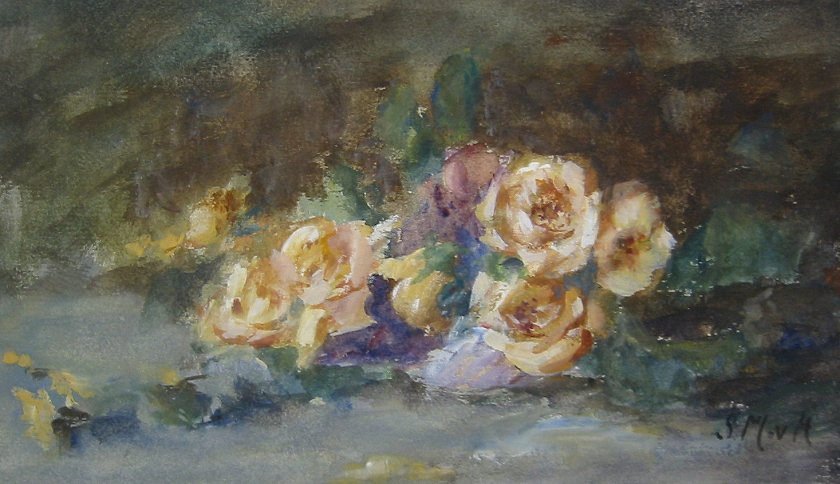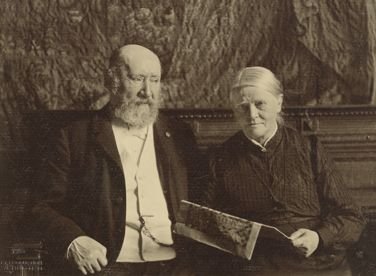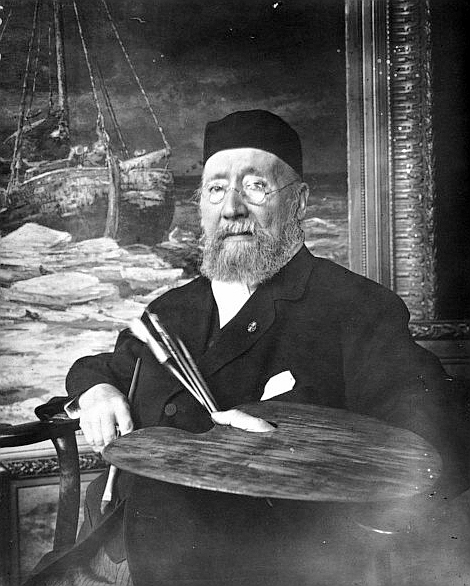
Following his visit to the Frisian island of Nordeney in the summer of 1868, Hendrik Mesdag would dedicate the rest of artistic life to seascapes and maritime paintings. He and his wife Sientje had moved back to The Hague in 1869, a town which was a short distance from the coastal district of Scheveningen which offered him the perfect situation for his seascape paintings.

Scheveningen, at the time of Mesdag, was a small fishing village which has since grown to become one of the most popular beach destinations of The Netherlands. In the 16th century the village of Scheveningen had less than 900 inhabitants whose livelihood was dependent on fishing. In the 19th century the main fishery was focussed on the catch of the herring. These were the golden times for the Scheveningen’s fishing industry but by the end of the 19th century the fishery almost ended since few young folk of Scheveningen followed in their fathers’ footsteps in becoming fishermen.

One of the main features in Mesdag’s seascape depictions was the fishermen and their flat-bottomed boats known as bomschuiten on the beaches at Scheveningen. When Mesdag went to live in The Hague, there was no harbour for the fishing boats and they would have to rest on the beach and the fishermen would simply pull them on and off the shore. To get them into the sea for the next fishing trip was quite a complex and unusual affair which I saw explained in a write-up on the Gallery Rob Kattenburg website.
“…At about six feet from the water’s edge a heavy anchor is placed in the sea with a smaller anchor fixed to the same cable to prevent the large anchor from what is known as ‘crabbing’ – that is, sliding over the bottom – when the boat is being launched. At a short distance from the vessel an even smaller anchor is fixed to the cable. The youngest anchorman, with the anchor over his shoulder, walks into the sea up to his neck and then drops the anchor. Only after this has been done are the fishermen carried one by one by the so-called carriers or swimmers and set down on a ladder placed at the stern of the vessel. Then the carriers themselves climb on board. A complete crew numbered nine men. Then the anchor cable is wound round a primitive wooden windlass and the handspikes are inserted. Simultaneously with each rolling wave the crew strains to pull the cable in and thus draw the ship out to sea until they reach deep water. At some distance from the coast the sail is hoisted and the boat sets off for the fishing grounds…”

The low lying Dutch coastline was often battered by storms, one of the worst being in 1470 when it destroyed the church and half the houses. The village was again hit by storms in 1570, 1775, 1825, 1860, 1881, and 1894, the latter being the most devastating. At that time a safe harbour had yet to be built and as usual the fishing fleet of the flat-bottomed bomschuiten had been pulled up on the beach. They were devastated by the ferocity of the storm and most were smashed to pieces and this devastation was captured in Henrik Mesdag’s painting After the Storm 1894. After this last storm, the villagers decided to build a harbour. Once the harbour had been constructed in 1904, more modern fishing boats replaced the bomschuiten.

The painting Hendrik Mesdag was probably best known for was his panorama painting which became known as Panorama Mesdag. I remember when I travelled to Venice many years ago, and visited the Gallerie dell’Academia I came across the enormous painting by Veronese entitled The Feast in the House of Levi. I could not believe how big it was – it measured 18ft high and 42ft in width. However, this fades into insignificance if you compare it to the size of Hendrik Mesdag’s Panorama which is 46ft high and 394ft in circumference (14m x 120m). Trust me, seeing is believing!

Panorama paintings had existed prior to Mesdag’s effort. A panorama or panoramic painting is a massive work of art, which depicts a wide and all-encompassing view of a subject. But what is a panorama? The word was coined by the Irish painter Robert Barker, the inventor of the visual panorama, by merging the Greek for pan, “all,” + orama, “that which is seen.” They could be depictions of a battle, historical event or a landscape and were very popular in the nineteenth century, a time before television or the cinema. The Irish artist, Robert Barker experimented with the idea of representing nature at a single glance. Barker was born at Kells, County Meath, in 1739. He set himself up as an artist in Dublin but was never very successful and eventually left Ireland and settled in Edinburgh, where once again he set himself up as a painter of portraits and as a miniature painter. If not a great painter, Barker was certainly a great inventor and devised a mechanical system of perspective which he taught. One day when atop Calton Hill, one of Edinburgh’s main hills set right in the city centre he had the idea of a panorama painting of the city below and in 1787, helped by his twelve-year old son, Henry, he made drawings of a half-circle view from the hill and later in his studio completed his picture in water-colour and took it to London where sadly, it was not well received. However, Barker believed in his project and completed a whole-circle view of Edinburgh twenty-five feet in diameter. He went on to exhibit the work in the Archer’s Hall at Holyrood and afterwards in the Assembly Rooms in George Street. Later in 1788 he exhibited the work in a large room in the Haymarket, London. Barker went on to complete many more panorama paintings.

In Belgium panoramas became very popular and Hendrik Mesdag received a commission from a Belgian panorama society, Societé Anonyme du Panorama Maritime de la Haye to paint a maritime panorama. They wanted the panorama, without borders, to be centred around the Seinpostduine, which at the time was the highest sand dune in Scheveningen and was in danger of being excavated to make room for a café-restaurant.

Mesdag accepted the commission believing it to be a great opportunity to depict his beloved picturesque coastal village of Scheveningen and so, he went about enlisting the help of a few artist friends from The Hague School. He invited George Hendrik Breitner, a young art student from The Hague Academy, whose task it was to sketch the village of Scheveningen, Théophile de Bock, a friend of van Gogh, was tasked to paint the sky and the dunes and the small contribution of Bernard Blommers was the painting of a fisherwoman and her child who are looking out to sea. Another contributor to this massive project was Mesdag’s wife Sientje, who he depicted in the painting sitting down with her easel under a white parasol. Mesdag set to work on the panorama in March 1881 building a sixteen-cornered building on Zeestraat in The Hague. It incorporated a 14-metre-high structure on which Mesdag could paint his work

Mesdag and his team of painters made numerous sketches of the town and the surrounding coast and slowly over the next four and a half months the panorama evolved. Mesdag was well satisfied with the finished result. He believed the painting gave an overwhelming impression of nature. Many believe he was influenced by his training at the hands of Willem Roelofs who had stressed the importance of reality painting. Roelofs had told Mesdag on many occasions to “paint reality and nothing but reality”.

The museum housing the panorama was opened to the public on August 1st 1881 but after five years it went bankrupt. Mesdag, who was concerned as to the fate of his panoramic painting, bought the museum, and kept it open despite it losing money year on year. Vincent van Gogh, an early visitor to Panorama Mesdag, in a letter to his brother Theo, dated August 26th 1881, wrote about the panorama:
“…then I saw Mesdag’s panorama with him [Théophile de Bock], that’s a work for which one must have the utmost respect. It put me in mind of what Bürger or Thoré, I think, said about Rembrandt’s Anatomy Lesson. That painting’s only fault is not to have any faults…”

I visited Panorama Mesdag at the beginning of December and it was truly an amazing experience. You enter the building, past the obligatory shop and into two small rooms which house some of Mesdag and his wife’s paintings. You then follow a corridor upwards through a dimly lit long passage which opens out to what looks a circular observation gallery surrounded by the enormous painting. The observation gallery has a circular walk way with rails all around it which you can lean against as you scan the painting. As you stand on the gallery platform, the painting is 14 metres away from you and between you and the painting is sand and various items of flotsam, abandoned fishing nets and marram grasses which make it seem that you are standing on top of a sand dune looking down to the sea on one side and the village on the opposite side. This addition of sand and bits of driftwood make the whole experience more realistic.
The museum housing the panorama was opened to the public on August 1st 1881 but after five years it went bankrupt. Mesdag, who was concerned as to the fate of his panoramic painting, bought the museum, and kept it open despite it losing money year on year.
In his later years Mesdag received many honours. In 1889, he was elected chairman of Pulchri Studio Painters’ Society, the society he joined twenty years earlier, and remained in that post until 1907. He received the royal distinction of Officer in the Order of Oranje-Nassau in 1894. In February 1901 Mesdag is promoted to Commander of the Order of the Dutch Lion.

In March 1909 his beloved Sientje died, aged 74. Two years later in 1911, Hendrik Mesdag was taken seriously ill and although he recovered, his health slowly deteriorated. Hendrik Willem Mesdag died in The Hague in July 1915, aged 84.
I end with a quote from the author, Frederick W Morton who wrote an article in the May 1903 edition of the American art journal, Brush and Pencil . He wrote about Mesdag’s seascapes:
“…Other artists have painted more witchery into their canvases, more tenseness and terror. A Mesdag has not the glint of colour one finds in a Clays or the awful meaning one reads in Homer. On the contrary, many of his canvases are rather heavy in tone and are works calculated to inspire quiet contemplation rather than to excite nervous. But he is a great marine-painter because he thoroughly knows his subject – he has sat by it, brooded over it, studied it in its every phase – and by straightforward methods, without the trick of palette or adventitious accessories, has sought to make and has succeeded in making his canvases convey the same impression to the spectator that the ocean conveyed to him…”
It is very difficult to describe the Panorama Mesdag experience but if you go to YouTube and type in “panorama mesdag” there are a number of videos showing you this wonderful painting.



















